Representation of the Past in History Textbooks
VerifiedAdded on 2022/11/01
|7
|2471
|166
AI Summary
This essay analyzes the representation of India’s past in the history textbooks of India, focusing on the historical inaccuracies and biased perspectives presented. It highlights the need for a more accurate and scientific understanding of history.
Contribute Materials
Your contribution can guide someone’s learning journey. Share your
documents today.
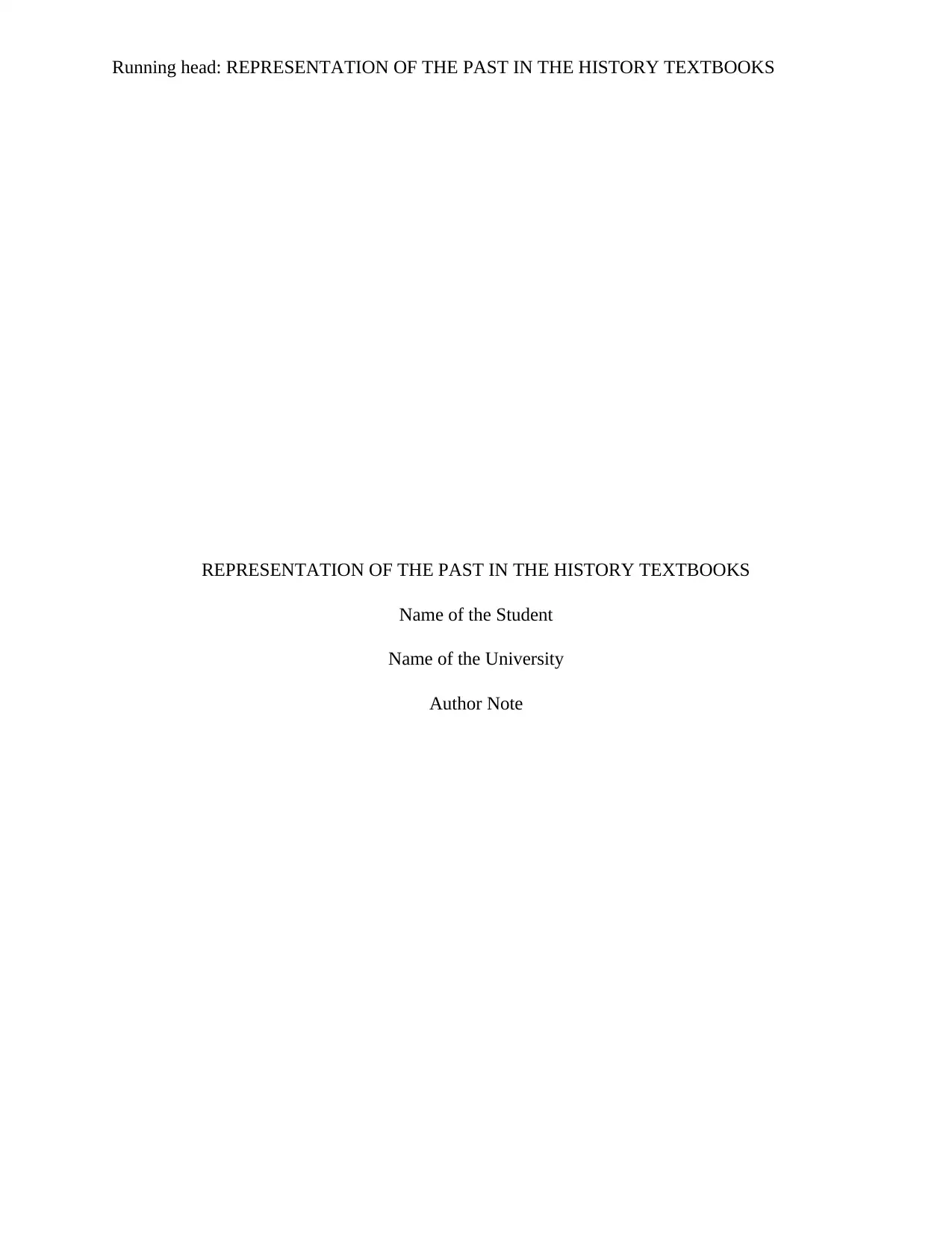
Running head: REPRESENTATION OF THE PAST IN THE HISTORY TEXTBOOKS
REPRESENTATION OF THE PAST IN THE HISTORY TEXTBOOKS
Name of the Student
Name of the University
Author Note
REPRESENTATION OF THE PAST IN THE HISTORY TEXTBOOKS
Name of the Student
Name of the University
Author Note
Secure Best Marks with AI Grader
Need help grading? Try our AI Grader for instant feedback on your assignments.
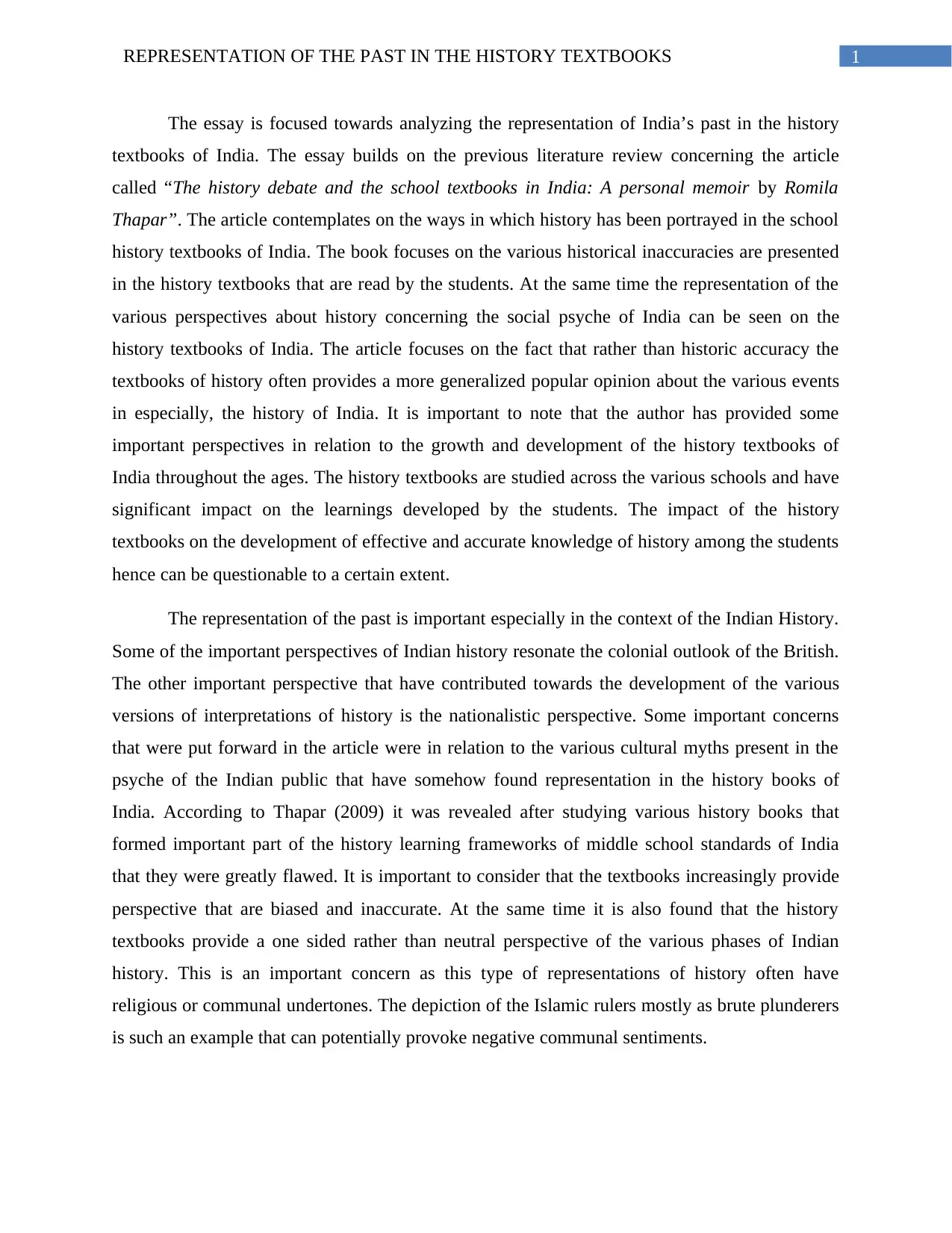
1REPRESENTATION OF THE PAST IN THE HISTORY TEXTBOOKS
The essay is focused towards analyzing the representation of India’s past in the history
textbooks of India. The essay builds on the previous literature review concerning the article
called “The history debate and the school textbooks in India: A personal memoir by Romila
Thapar”. The article contemplates on the ways in which history has been portrayed in the school
history textbooks of India. The book focuses on the various historical inaccuracies are presented
in the history textbooks that are read by the students. At the same time the representation of the
various perspectives about history concerning the social psyche of India can be seen on the
history textbooks of India. The article focuses on the fact that rather than historic accuracy the
textbooks of history often provides a more generalized popular opinion about the various events
in especially, the history of India. It is important to note that the author has provided some
important perspectives in relation to the growth and development of the history textbooks of
India throughout the ages. The history textbooks are studied across the various schools and have
significant impact on the learnings developed by the students. The impact of the history
textbooks on the development of effective and accurate knowledge of history among the students
hence can be questionable to a certain extent.
The representation of the past is important especially in the context of the Indian History.
Some of the important perspectives of Indian history resonate the colonial outlook of the British.
The other important perspective that have contributed towards the development of the various
versions of interpretations of history is the nationalistic perspective. Some important concerns
that were put forward in the article were in relation to the various cultural myths present in the
psyche of the Indian public that have somehow found representation in the history books of
India. According to Thapar (2009) it was revealed after studying various history books that
formed important part of the history learning frameworks of middle school standards of India
that they were greatly flawed. It is important to consider that the textbooks increasingly provide
perspective that are biased and inaccurate. At the same time it is also found that the history
textbooks provide a one sided rather than neutral perspective of the various phases of Indian
history. This is an important concern as this type of representations of history often have
religious or communal undertones. The depiction of the Islamic rulers mostly as brute plunderers
is such an example that can potentially provoke negative communal sentiments.
The essay is focused towards analyzing the representation of India’s past in the history
textbooks of India. The essay builds on the previous literature review concerning the article
called “The history debate and the school textbooks in India: A personal memoir by Romila
Thapar”. The article contemplates on the ways in which history has been portrayed in the school
history textbooks of India. The book focuses on the various historical inaccuracies are presented
in the history textbooks that are read by the students. At the same time the representation of the
various perspectives about history concerning the social psyche of India can be seen on the
history textbooks of India. The article focuses on the fact that rather than historic accuracy the
textbooks of history often provides a more generalized popular opinion about the various events
in especially, the history of India. It is important to note that the author has provided some
important perspectives in relation to the growth and development of the history textbooks of
India throughout the ages. The history textbooks are studied across the various schools and have
significant impact on the learnings developed by the students. The impact of the history
textbooks on the development of effective and accurate knowledge of history among the students
hence can be questionable to a certain extent.
The representation of the past is important especially in the context of the Indian History.
Some of the important perspectives of Indian history resonate the colonial outlook of the British.
The other important perspective that have contributed towards the development of the various
versions of interpretations of history is the nationalistic perspective. Some important concerns
that were put forward in the article were in relation to the various cultural myths present in the
psyche of the Indian public that have somehow found representation in the history books of
India. According to Thapar (2009) it was revealed after studying various history books that
formed important part of the history learning frameworks of middle school standards of India
that they were greatly flawed. It is important to consider that the textbooks increasingly provide
perspective that are biased and inaccurate. At the same time it is also found that the history
textbooks provide a one sided rather than neutral perspective of the various phases of Indian
history. This is an important concern as this type of representations of history often have
religious or communal undertones. The depiction of the Islamic rulers mostly as brute plunderers
is such an example that can potentially provoke negative communal sentiments.
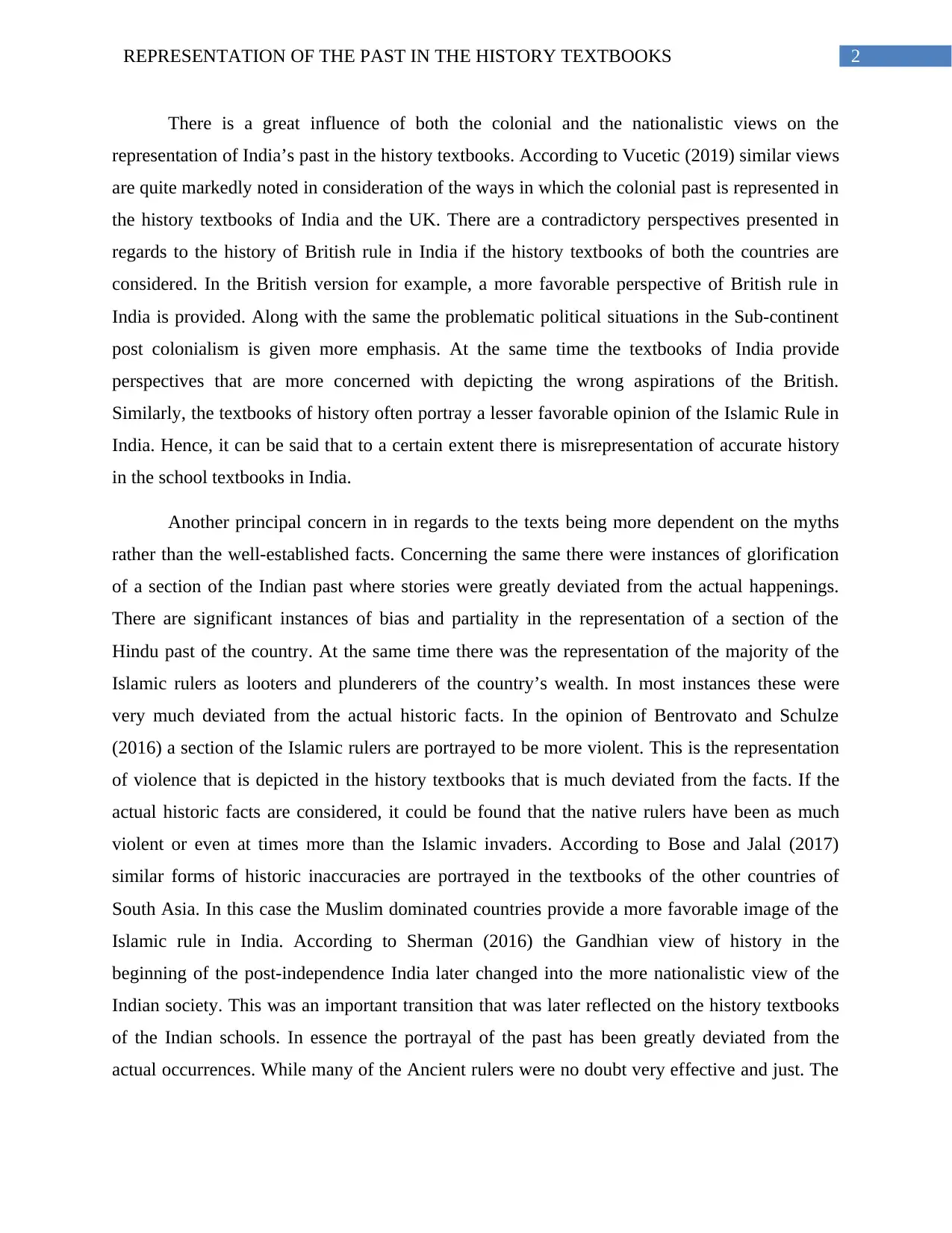
2REPRESENTATION OF THE PAST IN THE HISTORY TEXTBOOKS
There is a great influence of both the colonial and the nationalistic views on the
representation of India’s past in the history textbooks. According to Vucetic (2019) similar views
are quite markedly noted in consideration of the ways in which the colonial past is represented in
the history textbooks of India and the UK. There are a contradictory perspectives presented in
regards to the history of British rule in India if the history textbooks of both the countries are
considered. In the British version for example, a more favorable perspective of British rule in
India is provided. Along with the same the problematic political situations in the Sub-continent
post colonialism is given more emphasis. At the same time the textbooks of India provide
perspectives that are more concerned with depicting the wrong aspirations of the British.
Similarly, the textbooks of history often portray a lesser favorable opinion of the Islamic Rule in
India. Hence, it can be said that to a certain extent there is misrepresentation of accurate history
in the school textbooks in India.
Another principal concern in in regards to the texts being more dependent on the myths
rather than the well-established facts. Concerning the same there were instances of glorification
of a section of the Indian past where stories were greatly deviated from the actual happenings.
There are significant instances of bias and partiality in the representation of a section of the
Hindu past of the country. At the same time there was the representation of the majority of the
Islamic rulers as looters and plunderers of the country’s wealth. In most instances these were
very much deviated from the actual historic facts. In the opinion of Bentrovato and Schulze
(2016) a section of the Islamic rulers are portrayed to be more violent. This is the representation
of violence that is depicted in the history textbooks that is much deviated from the facts. If the
actual historic facts are considered, it could be found that the native rulers have been as much
violent or even at times more than the Islamic invaders. According to Bose and Jalal (2017)
similar forms of historic inaccuracies are portrayed in the textbooks of the other countries of
South Asia. In this case the Muslim dominated countries provide a more favorable image of the
Islamic rule in India. According to Sherman (2016) the Gandhian view of history in the
beginning of the post-independence India later changed into the more nationalistic view of the
Indian society. This was an important transition that was later reflected on the history textbooks
of the Indian schools. In essence the portrayal of the past has been greatly deviated from the
actual occurrences. While many of the Ancient rulers were no doubt very effective and just. The
There is a great influence of both the colonial and the nationalistic views on the
representation of India’s past in the history textbooks. According to Vucetic (2019) similar views
are quite markedly noted in consideration of the ways in which the colonial past is represented in
the history textbooks of India and the UK. There are a contradictory perspectives presented in
regards to the history of British rule in India if the history textbooks of both the countries are
considered. In the British version for example, a more favorable perspective of British rule in
India is provided. Along with the same the problematic political situations in the Sub-continent
post colonialism is given more emphasis. At the same time the textbooks of India provide
perspectives that are more concerned with depicting the wrong aspirations of the British.
Similarly, the textbooks of history often portray a lesser favorable opinion of the Islamic Rule in
India. Hence, it can be said that to a certain extent there is misrepresentation of accurate history
in the school textbooks in India.
Another principal concern in in regards to the texts being more dependent on the myths
rather than the well-established facts. Concerning the same there were instances of glorification
of a section of the Indian past where stories were greatly deviated from the actual happenings.
There are significant instances of bias and partiality in the representation of a section of the
Hindu past of the country. At the same time there was the representation of the majority of the
Islamic rulers as looters and plunderers of the country’s wealth. In most instances these were
very much deviated from the actual historic facts. In the opinion of Bentrovato and Schulze
(2016) a section of the Islamic rulers are portrayed to be more violent. This is the representation
of violence that is depicted in the history textbooks that is much deviated from the facts. If the
actual historic facts are considered, it could be found that the native rulers have been as much
violent or even at times more than the Islamic invaders. According to Bose and Jalal (2017)
similar forms of historic inaccuracies are portrayed in the textbooks of the other countries of
South Asia. In this case the Muslim dominated countries provide a more favorable image of the
Islamic rule in India. According to Sherman (2016) the Gandhian view of history in the
beginning of the post-independence India later changed into the more nationalistic view of the
Indian society. This was an important transition that was later reflected on the history textbooks
of the Indian schools. In essence the portrayal of the past has been greatly deviated from the
actual occurrences. While many of the Ancient rulers were no doubt very effective and just. The
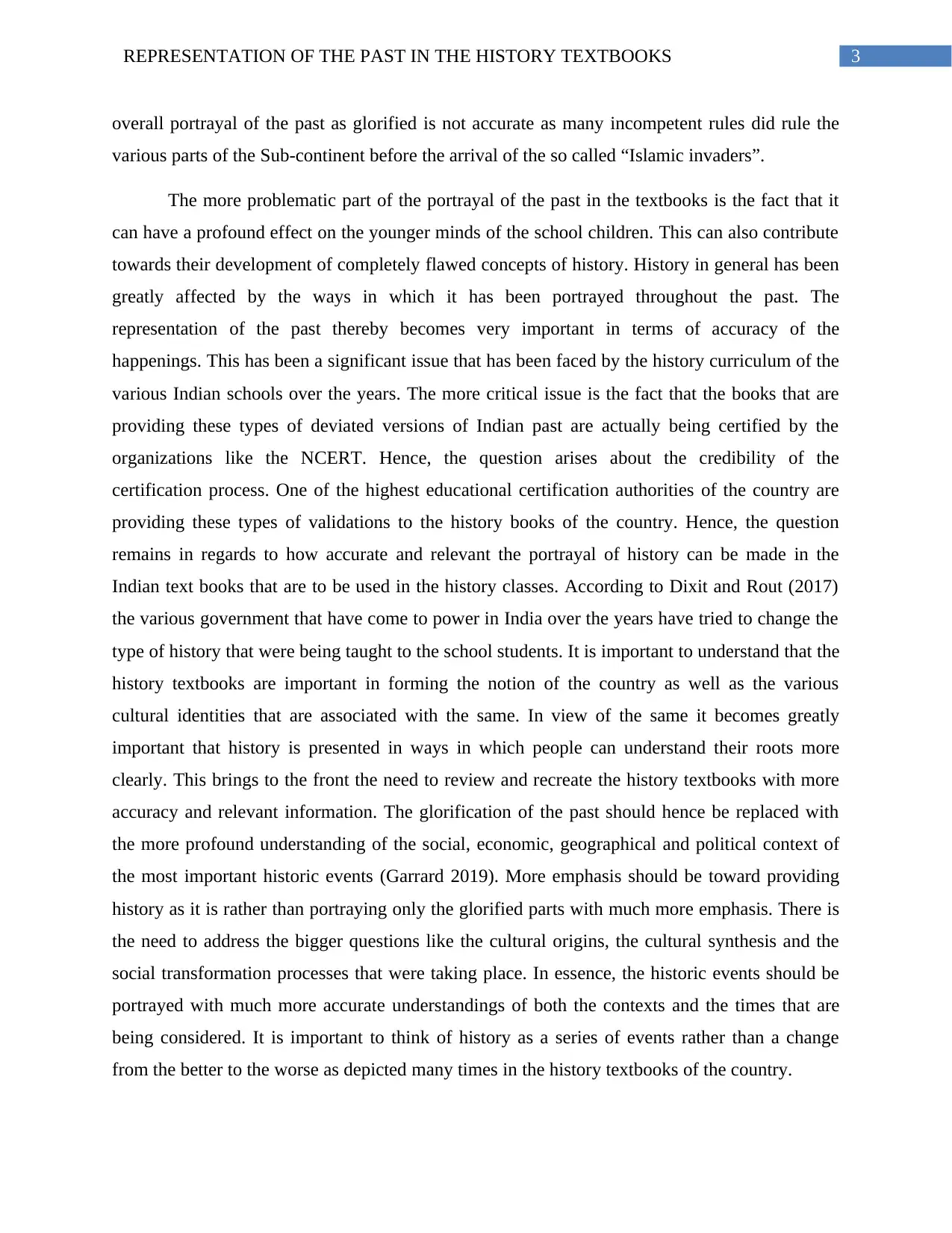
3REPRESENTATION OF THE PAST IN THE HISTORY TEXTBOOKS
overall portrayal of the past as glorified is not accurate as many incompetent rules did rule the
various parts of the Sub-continent before the arrival of the so called “Islamic invaders”.
The more problematic part of the portrayal of the past in the textbooks is the fact that it
can have a profound effect on the younger minds of the school children. This can also contribute
towards their development of completely flawed concepts of history. History in general has been
greatly affected by the ways in which it has been portrayed throughout the past. The
representation of the past thereby becomes very important in terms of accuracy of the
happenings. This has been a significant issue that has been faced by the history curriculum of the
various Indian schools over the years. The more critical issue is the fact that the books that are
providing these types of deviated versions of Indian past are actually being certified by the
organizations like the NCERT. Hence, the question arises about the credibility of the
certification process. One of the highest educational certification authorities of the country are
providing these types of validations to the history books of the country. Hence, the question
remains in regards to how accurate and relevant the portrayal of history can be made in the
Indian text books that are to be used in the history classes. According to Dixit and Rout (2017)
the various government that have come to power in India over the years have tried to change the
type of history that were being taught to the school students. It is important to understand that the
history textbooks are important in forming the notion of the country as well as the various
cultural identities that are associated with the same. In view of the same it becomes greatly
important that history is presented in ways in which people can understand their roots more
clearly. This brings to the front the need to review and recreate the history textbooks with more
accuracy and relevant information. The glorification of the past should hence be replaced with
the more profound understanding of the social, economic, geographical and political context of
the most important historic events (Garrard 2019). More emphasis should be toward providing
history as it is rather than portraying only the glorified parts with much more emphasis. There is
the need to address the bigger questions like the cultural origins, the cultural synthesis and the
social transformation processes that were taking place. In essence, the historic events should be
portrayed with much more accurate understandings of both the contexts and the times that are
being considered. It is important to think of history as a series of events rather than a change
from the better to the worse as depicted many times in the history textbooks of the country.
overall portrayal of the past as glorified is not accurate as many incompetent rules did rule the
various parts of the Sub-continent before the arrival of the so called “Islamic invaders”.
The more problematic part of the portrayal of the past in the textbooks is the fact that it
can have a profound effect on the younger minds of the school children. This can also contribute
towards their development of completely flawed concepts of history. History in general has been
greatly affected by the ways in which it has been portrayed throughout the past. The
representation of the past thereby becomes very important in terms of accuracy of the
happenings. This has been a significant issue that has been faced by the history curriculum of the
various Indian schools over the years. The more critical issue is the fact that the books that are
providing these types of deviated versions of Indian past are actually being certified by the
organizations like the NCERT. Hence, the question arises about the credibility of the
certification process. One of the highest educational certification authorities of the country are
providing these types of validations to the history books of the country. Hence, the question
remains in regards to how accurate and relevant the portrayal of history can be made in the
Indian text books that are to be used in the history classes. According to Dixit and Rout (2017)
the various government that have come to power in India over the years have tried to change the
type of history that were being taught to the school students. It is important to understand that the
history textbooks are important in forming the notion of the country as well as the various
cultural identities that are associated with the same. In view of the same it becomes greatly
important that history is presented in ways in which people can understand their roots more
clearly. This brings to the front the need to review and recreate the history textbooks with more
accuracy and relevant information. The glorification of the past should hence be replaced with
the more profound understanding of the social, economic, geographical and political context of
the most important historic events (Garrard 2019). More emphasis should be toward providing
history as it is rather than portraying only the glorified parts with much more emphasis. There is
the need to address the bigger questions like the cultural origins, the cultural synthesis and the
social transformation processes that were taking place. In essence, the historic events should be
portrayed with much more accurate understandings of both the contexts and the times that are
being considered. It is important to think of history as a series of events rather than a change
from the better to the worse as depicted many times in the history textbooks of the country.
Secure Best Marks with AI Grader
Need help grading? Try our AI Grader for instant feedback on your assignments.
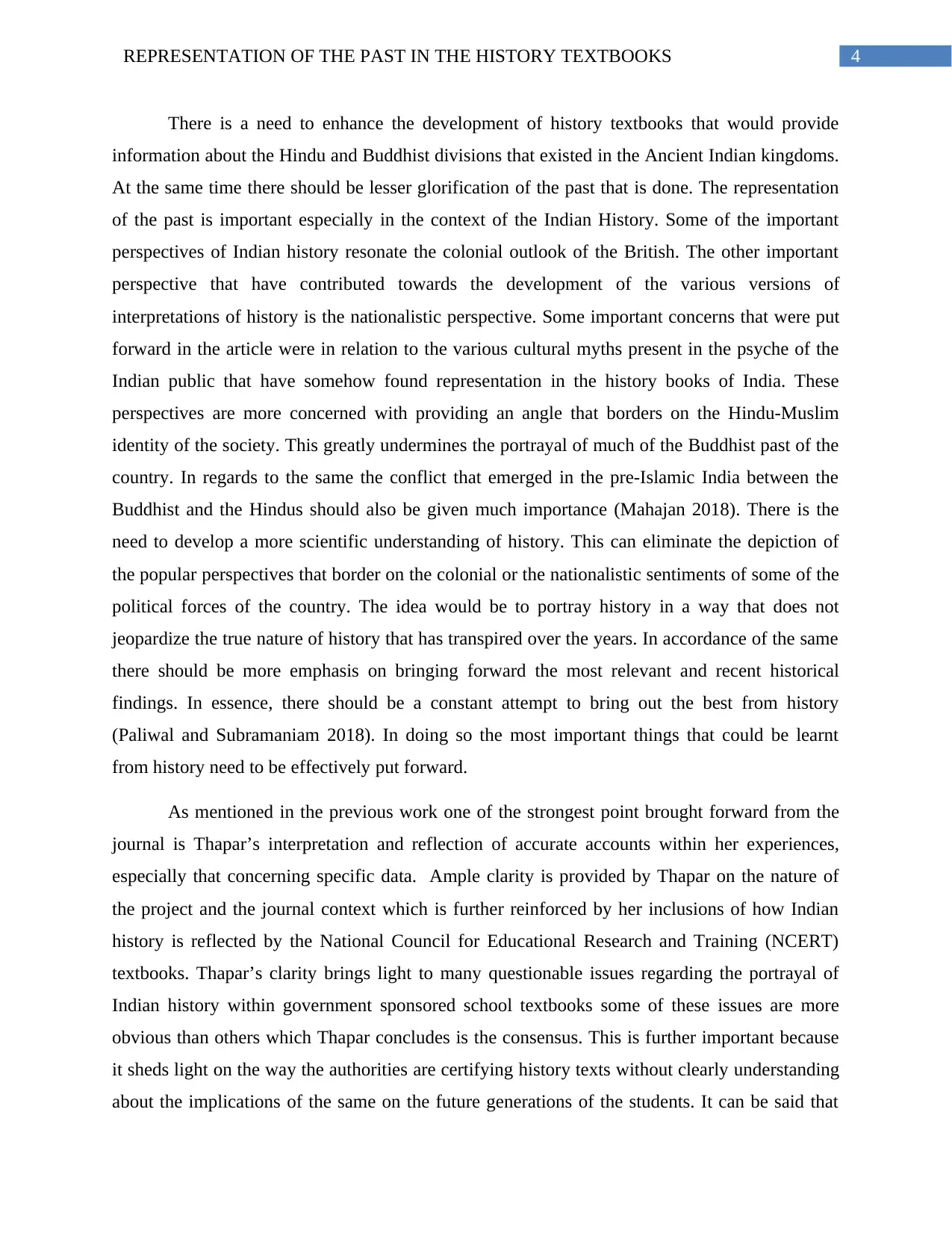
4REPRESENTATION OF THE PAST IN THE HISTORY TEXTBOOKS
There is a need to enhance the development of history textbooks that would provide
information about the Hindu and Buddhist divisions that existed in the Ancient Indian kingdoms.
At the same time there should be lesser glorification of the past that is done. The representation
of the past is important especially in the context of the Indian History. Some of the important
perspectives of Indian history resonate the colonial outlook of the British. The other important
perspective that have contributed towards the development of the various versions of
interpretations of history is the nationalistic perspective. Some important concerns that were put
forward in the article were in relation to the various cultural myths present in the psyche of the
Indian public that have somehow found representation in the history books of India. These
perspectives are more concerned with providing an angle that borders on the Hindu-Muslim
identity of the society. This greatly undermines the portrayal of much of the Buddhist past of the
country. In regards to the same the conflict that emerged in the pre-Islamic India between the
Buddhist and the Hindus should also be given much importance (Mahajan 2018). There is the
need to develop a more scientific understanding of history. This can eliminate the depiction of
the popular perspectives that border on the colonial or the nationalistic sentiments of some of the
political forces of the country. The idea would be to portray history in a way that does not
jeopardize the true nature of history that has transpired over the years. In accordance of the same
there should be more emphasis on bringing forward the most relevant and recent historical
findings. In essence, there should be a constant attempt to bring out the best from history
(Paliwal and Subramaniam 2018). In doing so the most important things that could be learnt
from history need to be effectively put forward.
As mentioned in the previous work one of the strongest point brought forward from the
journal is Thapar’s interpretation and reflection of accurate accounts within her experiences,
especially that concerning specific data. Ample clarity is provided by Thapar on the nature of
the project and the journal context which is further reinforced by her inclusions of how Indian
history is reflected by the National Council for Educational Research and Training (NCERT)
textbooks. Thapar’s clarity brings light to many questionable issues regarding the portrayal of
Indian history within government sponsored school textbooks some of these issues are more
obvious than others which Thapar concludes is the consensus. This is further important because
it sheds light on the way the authorities are certifying history texts without clearly understanding
about the implications of the same on the future generations of the students. It can be said that
There is a need to enhance the development of history textbooks that would provide
information about the Hindu and Buddhist divisions that existed in the Ancient Indian kingdoms.
At the same time there should be lesser glorification of the past that is done. The representation
of the past is important especially in the context of the Indian History. Some of the important
perspectives of Indian history resonate the colonial outlook of the British. The other important
perspective that have contributed towards the development of the various versions of
interpretations of history is the nationalistic perspective. Some important concerns that were put
forward in the article were in relation to the various cultural myths present in the psyche of the
Indian public that have somehow found representation in the history books of India. These
perspectives are more concerned with providing an angle that borders on the Hindu-Muslim
identity of the society. This greatly undermines the portrayal of much of the Buddhist past of the
country. In regards to the same the conflict that emerged in the pre-Islamic India between the
Buddhist and the Hindus should also be given much importance (Mahajan 2018). There is the
need to develop a more scientific understanding of history. This can eliminate the depiction of
the popular perspectives that border on the colonial or the nationalistic sentiments of some of the
political forces of the country. The idea would be to portray history in a way that does not
jeopardize the true nature of history that has transpired over the years. In accordance of the same
there should be more emphasis on bringing forward the most relevant and recent historical
findings. In essence, there should be a constant attempt to bring out the best from history
(Paliwal and Subramaniam 2018). In doing so the most important things that could be learnt
from history need to be effectively put forward.
As mentioned in the previous work one of the strongest point brought forward from the
journal is Thapar’s interpretation and reflection of accurate accounts within her experiences,
especially that concerning specific data. Ample clarity is provided by Thapar on the nature of
the project and the journal context which is further reinforced by her inclusions of how Indian
history is reflected by the National Council for Educational Research and Training (NCERT)
textbooks. Thapar’s clarity brings light to many questionable issues regarding the portrayal of
Indian history within government sponsored school textbooks some of these issues are more
obvious than others which Thapar concludes is the consensus. This is further important because
it sheds light on the way the authorities are certifying history texts without clearly understanding
about the implications of the same on the future generations of the students. It can be said that
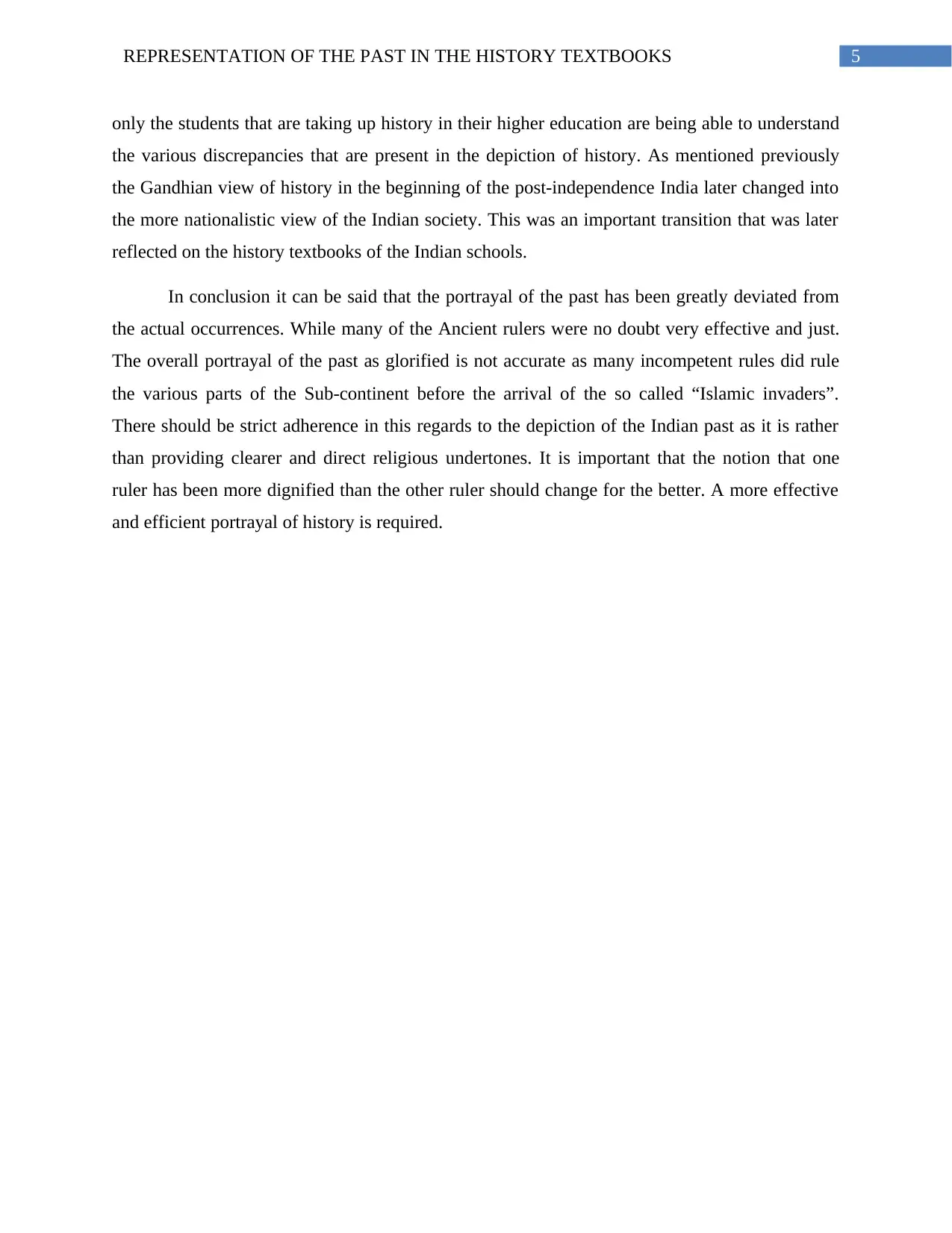
5REPRESENTATION OF THE PAST IN THE HISTORY TEXTBOOKS
only the students that are taking up history in their higher education are being able to understand
the various discrepancies that are present in the depiction of history. As mentioned previously
the Gandhian view of history in the beginning of the post-independence India later changed into
the more nationalistic view of the Indian society. This was an important transition that was later
reflected on the history textbooks of the Indian schools.
In conclusion it can be said that the portrayal of the past has been greatly deviated from
the actual occurrences. While many of the Ancient rulers were no doubt very effective and just.
The overall portrayal of the past as glorified is not accurate as many incompetent rules did rule
the various parts of the Sub-continent before the arrival of the so called “Islamic invaders”.
There should be strict adherence in this regards to the depiction of the Indian past as it is rather
than providing clearer and direct religious undertones. It is important that the notion that one
ruler has been more dignified than the other ruler should change for the better. A more effective
and efficient portrayal of history is required.
only the students that are taking up history in their higher education are being able to understand
the various discrepancies that are present in the depiction of history. As mentioned previously
the Gandhian view of history in the beginning of the post-independence India later changed into
the more nationalistic view of the Indian society. This was an important transition that was later
reflected on the history textbooks of the Indian schools.
In conclusion it can be said that the portrayal of the past has been greatly deviated from
the actual occurrences. While many of the Ancient rulers were no doubt very effective and just.
The overall portrayal of the past as glorified is not accurate as many incompetent rules did rule
the various parts of the Sub-continent before the arrival of the so called “Islamic invaders”.
There should be strict adherence in this regards to the depiction of the Indian past as it is rather
than providing clearer and direct religious undertones. It is important that the notion that one
ruler has been more dignified than the other ruler should change for the better. A more effective
and efficient portrayal of history is required.
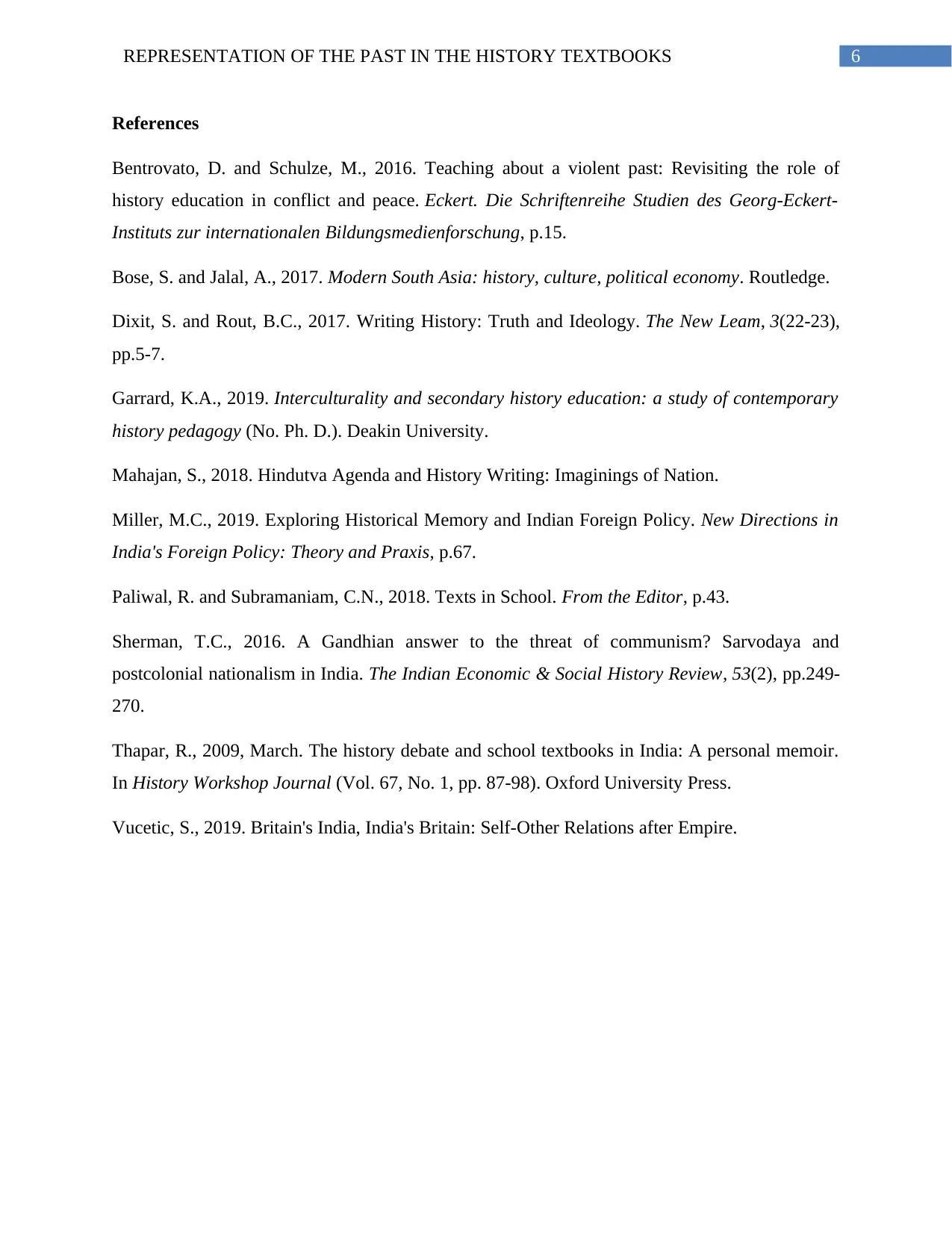
6REPRESENTATION OF THE PAST IN THE HISTORY TEXTBOOKS
References
Bentrovato, D. and Schulze, M., 2016. Teaching about a violent past: Revisiting the role of
history education in conflict and peace. Eckert. Die Schriftenreihe Studien des Georg-Eckert-
Instituts zur internationalen Bildungsmedienforschung, p.15.
Bose, S. and Jalal, A., 2017. Modern South Asia: history, culture, political economy. Routledge.
Dixit, S. and Rout, B.C., 2017. Writing History: Truth and Ideology. The New Leam, 3(22-23),
pp.5-7.
Garrard, K.A., 2019. Interculturality and secondary history education: a study of contemporary
history pedagogy (No. Ph. D.). Deakin University.
Mahajan, S., 2018. Hindutva Agenda and History Writing: Imaginings of Nation.
Miller, M.C., 2019. Exploring Historical Memory and Indian Foreign Policy. New Directions in
India's Foreign Policy: Theory and Praxis, p.67.
Paliwal, R. and Subramaniam, C.N., 2018. Texts in School. From the Editor, p.43.
Sherman, T.C., 2016. A Gandhian answer to the threat of communism? Sarvodaya and
postcolonial nationalism in India. The Indian Economic & Social History Review, 53(2), pp.249-
270.
Thapar, R., 2009, March. The history debate and school textbooks in India: A personal memoir.
In History Workshop Journal (Vol. 67, No. 1, pp. 87-98). Oxford University Press.
Vucetic, S., 2019. Britain's India, India's Britain: Self-Other Relations after Empire.
References
Bentrovato, D. and Schulze, M., 2016. Teaching about a violent past: Revisiting the role of
history education in conflict and peace. Eckert. Die Schriftenreihe Studien des Georg-Eckert-
Instituts zur internationalen Bildungsmedienforschung, p.15.
Bose, S. and Jalal, A., 2017. Modern South Asia: history, culture, political economy. Routledge.
Dixit, S. and Rout, B.C., 2017. Writing History: Truth and Ideology. The New Leam, 3(22-23),
pp.5-7.
Garrard, K.A., 2019. Interculturality and secondary history education: a study of contemporary
history pedagogy (No. Ph. D.). Deakin University.
Mahajan, S., 2018. Hindutva Agenda and History Writing: Imaginings of Nation.
Miller, M.C., 2019. Exploring Historical Memory and Indian Foreign Policy. New Directions in
India's Foreign Policy: Theory and Praxis, p.67.
Paliwal, R. and Subramaniam, C.N., 2018. Texts in School. From the Editor, p.43.
Sherman, T.C., 2016. A Gandhian answer to the threat of communism? Sarvodaya and
postcolonial nationalism in India. The Indian Economic & Social History Review, 53(2), pp.249-
270.
Thapar, R., 2009, March. The history debate and school textbooks in India: A personal memoir.
In History Workshop Journal (Vol. 67, No. 1, pp. 87-98). Oxford University Press.
Vucetic, S., 2019. Britain's India, India's Britain: Self-Other Relations after Empire.
1 out of 7
Related Documents
Your All-in-One AI-Powered Toolkit for Academic Success.
+13062052269
info@desklib.com
Available 24*7 on WhatsApp / Email
![[object Object]](/_next/static/media/star-bottom.7253800d.svg)
Unlock your academic potential
© 2024 | Zucol Services PVT LTD | All rights reserved.





